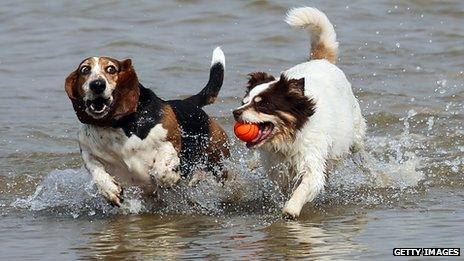Scientists decipher dog-tail wags
- Published

According to the scientists, a dog's tail wag can reveal its mood
Scientists have shed more light on how the movements of a dog's tail are linked to its mood.
Earlier research had revealed that happy dogs wag their tails more to the right (from the dog's point of view), while nervous dogs have a left-dominated swish.
But now scientists say that fellow canines can spot and respond to these subtle tail differences.
The study is published in the journal Current Biology, external.
Prof Georgio Vallortigara, a neuroscientist from the University of Trento, said: "It is very well known in humans that the left and right side of the brain are differently involved in stimuli that invokes positive or negative emotions.
"Here we attempted to look at it in other species."
Dr John Bradshaw: "The breakthrough is that dogs are reading one another's body language"
He added that just as in humans, for dogs the right side of the brain was responsible for left-handed movement and vice versa, and the two hemispheres played different roles in emotions.
Dogs on film
To find out more about how dogs react to the lop-sided tail wags of other dogs, the researchers monitored the animals as they watched films of other dogs.
They measured the pets' heart rates and analysed their behaviour.
Prof Vallortigara said: "We presented dogs with movies of dogs - either a naturalistic version or a silhouette to get rid of any other confounding issues, and we could doctor the movement of the tail and present the tail more to the left or right."
When the animals saw an otherwise expressionless dog move its tail to the right (from the tail-wagging dog's point of view), they stayed perfectly relaxed.
But when they spotted a tail veer predominantly to the left (again from the tail-swishing dog's point of view), their heart rates picked up and they looked anxious.
Prof Vallortigara said he didn't think that the dogs were intentionally communicating with each other through these movements.
Instead, he believes that they dogs have learned from experience what moves they should and shouldn't feel worried about.
He said: "If you have several meetings with other dogs, and frequently their tail wagging one way is associated with a more friendly behaviour, and the right side is producing a less friendly behaviour, you respond on the basis of that experience."

The team says dogs respond to lop-sided tail wags from other dogs
The researchers say the findings could give owners, vets and trainers a better insight into their animal's emotions.
Dog behaviour expert John Bradshaw, a visiting fellow at the University of Bristol's school of veterinary science, said this was not the first study to examine whether left and right were important to canines.
Last year a team from the University of Lincoln found that dogs turn their heads to the left when looking at an aggressive dog and to the right when looking at a happy dog.
And in another research paper from the University of Victoria in Canada, he said: "Dogs were more likely to approach a robot dog when its 'tail' was made to wag left rather than right, rather than becoming anxious - the opposite way around to the [Italian] study."
He said the differences could be because the dogs in the different studies were not fully interpreting the animals in the films or robo-dogs as canines. A study of how dogs responded to real dogs could help, he explained.
"While there is considerable evidence from many different mammals that the two sides of the brain are used for different purposes, much of the detail still has to be hammered out - and dogs are no exception," he said.
"However, given the ease with which their behaviour can be recorded, it will probably not be long before we understand why their tails sometimes go one way, sometimes the other."
- Published11 July 2013
- Published23 January 2013